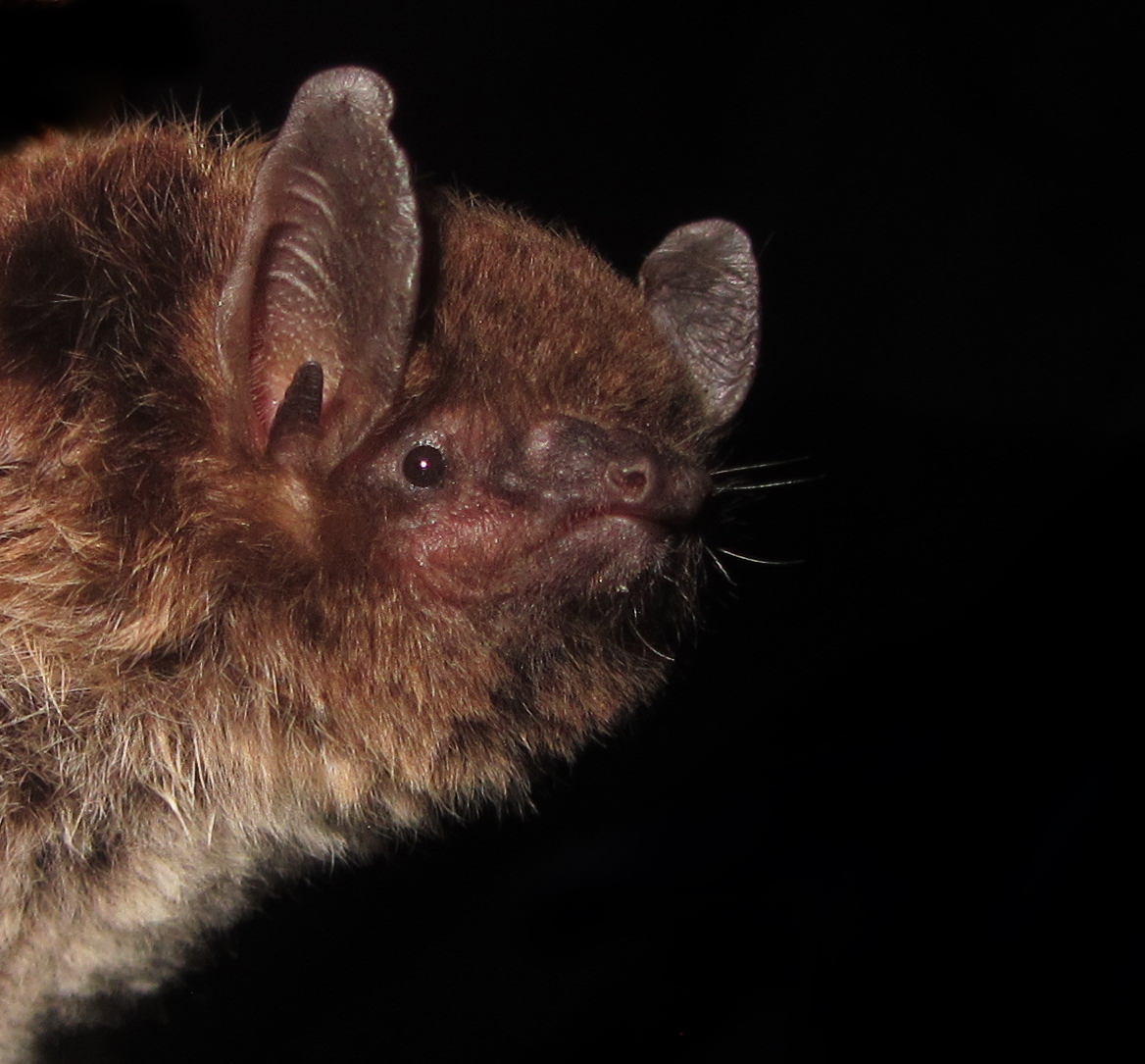NOTES ON AN ARTIFICIAL ROOST OF Myotis albescens (CHIROPTERA, VESPERTILIONIDAE) IN SOUTHEASTERN BRAZIL
DOI:
https://doi.org/10.4257/oeco.2021.2504.06Palavras-chave:
Atlantic Forest, highway underpasses, São Paulo state, Silver-tipped MyotisResumo
Myotis albescens has a wide distribution, occurring from southern Mexico to central Argentina and Uruguay, where it is usually caught near streams or flooded areas. M. albescens roosts during the day in cavities such as hollow logs, rock cavities, and buildings. Here, we describe a group of M. albescens roosting in a highway underpass in an Atlantic Forest area in Rancharia, southeastern Brazil. The group was found inside a culvert with a shallow stream passing through it. The animals left the roost and were mist-netted in the first hours of the night. The M. albescens group was composed of 18 individuals, eleven males and seven females. In October, all males had descended testes and two females were pregnant, as confirmed by abdominal palpation. Morphological characters of the specimens fell in the known variation for the species. Our data show that highway underpasses can be important day roosts for bats, especially if riparian areas are preserved
Referências
Acosta y Lara, E. F. 1950. Quirópteros del Uruguay. Comunicaciones Zoolóogicas Del Museo de Historia Natural de Montevideo.
Barquez, R. M. 1988. Notes on identity, distribution, and ecology of some Argentine bats. Journal of Mammalogy, 69(4), 873–876.
Braun, J. K., Layman, Q. D., & Mares, M. A. 2009. Myotis albescens (Chiroptera: Vespertilionidae). Mammalian Species, 846, 1–9. DOI: 10.1644/846.1
Handley, C. O. 1976. Mammals of the Smithsonian Venezuelan Project. Brigham Young University Science Bulletin, Biological Series, 20(5), 1–89. DOI: http://scholarsarchive.byu.edu/byuscib/vol20/iss5/1/
LaVal, R. K. 1973. A revision of the Neotropical bats of the genus Myotis. Natural History Museum Los Angeles County Science Bulletin, 15, 1–54.
Medellín, R. A. 2014. Myotis albescens (È. Geoffroy St.-Hilaire, 1806). In: G. Ceballos (Ed.), Mammals of Mexico. pp. 782–783. Baltimore, MD: Johns Hopkins University Press.
Miranda, J. M. D., Pulchério-Leite, A., Bernardi, I. P., & Passos, F. de C. 2007. Primeiro registro de Myotis albescens (É. Geoffroy, 1806) (Chiroptera, Vespertilionidae) para o Estado do Paraná, Brasil. Biota Neotropica, 7(1), 231–233.
Moratelli, R., Burgin, C. J., Cláudio, V. C., Novaes, R. L. M., López-Baucells, A., & Haslauer, R. 2019. Family Vespertilionidae (Vesper Bats). In: D.E. Wilson & R. A. Mittermeier (Eds.), Handbook of the Mammals of the World, Bats, Vol. 9. pp. 716–981. Barcelona: Lynx Edicions.
Moratelli, R., & de Oliveira, J. A. 2011. Morphometric and morphological variation in South American populations of Myotis albescens (Chiroptera: Vespertilionidae). Zoologia, 28(6), 789–802. DOI: 10.1590/S1984-46702011000600013
Moratelli, R., Dewynter, M., Delaval, M., Catzeflis, F., & Ruedi, M. 2015. First record of Myotis albescens (Chiroptera, Vespertilionidae) in French Guiana. Biodiversity Data Journal, 3(1). DOI: 10.3897/BDJ.3.e5314
Myers, P. 1977. Patterns of reproduction of four species of vespertilionid bats in Paraguay. University of California Publications in Zoology, 107, 1–41.
Patterson, B. D. 1992. Mammals in the Royal Natural History Museum, Stockholm, Collected in Brazil and Bolivia by A. M. Olalla during 1934-1938. Fieldiana Zoology, New Series, 66, 1–64.
Prist, P. R., Garbino, G. S. T., Abra, F. D., Pagotto, T., & Giacon, O. O. 2020. Use of highway culverts by the water opossum (Chironectes minimus) in southeastern Brazil. Biota Neotropica, 20(4), e20201058. DOI: 10.1590/1676-0611-BN-2020-1058
Ribeiro, M. C., Metzger, J. P., Martensen, A. C., Ponzoni, F. J., & Hirota, M. M. 2009. The Brazilian Atlantic Forest: How much is left, and how is the remaining forest distributed? Implications for conservation. Biological Conservation, 142(6), 1141–1153. DOI: 10.1016/j.biocon.2009.02.021
Voss, R. S., Fleck, D. W., Strauss, R. E., Velazco, P. M., & Simmons, N. B. 2016. Roosting ecology of Amazonian bats: evidence for guild structure in hyperdiverse mammalian communities. American Museum Novitates, 3870(3870), 1–43. DOI: 10.1206/3870.1
Wied, M. P. 1826. Beiträge zur Naturgeschichte von Brasilien. II. Band. Weimar: Landes‐Industrie‐Comptoir: p. 620.
Wilson, Don E. 2008. Genus Myotis Kaup, 1829. In: A. L. Gardner (Ed.), Mammals of South America, Volume 1: marsupials, xenarthrans, shrews, and bats. pp. 468–481. Chicago, IL: The University of Chicago Press.


